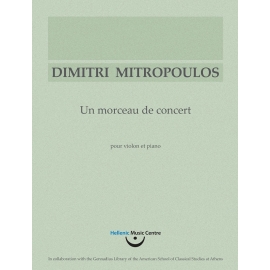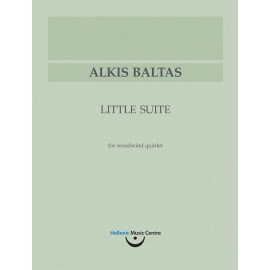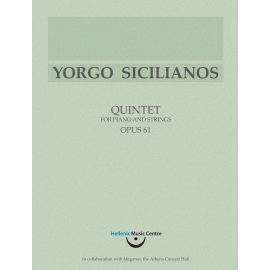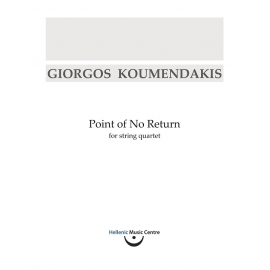No products
Product successfully added to your shopping cart
There are 0 items in your cart. There is 1 item in your cart.
 View larger
View larger
Kyriakou: Concerto for Piano and Orchestra, opus 18
HMC 019
New
Rena Kyriakou (1917-1994)
Concerto for Piano and Orchestra, Op. 18 (1938-40)
Reduction for Two Pianos (Transcription: Nikos Poulakis)
Published in collaboration with the Athens State Orchestra
Duration: 25’
ISMN: 979-0-801168-07-8
Pages: 81
Score editing: Yannis Samprovalakis
Score designing: Nikos Poulakis
Foreword: Ioannis Fulias
English translation: Helena Grigorea
Graphic design: Antonis Kapiris
Details
| Composer | Kyriakou, Rena |
More info
Introductory Note
The name of Rena Kyriakou (1917-1994) is mainly associated with her high-standard interpretations as a pianist, both at concerts in Greece, Europe and America and in recordings of works by FelixMendelssohn-Bartholdy (his complete piano works), Antonio Soler, John Field, Emmanuel Chabrier, Isaac Albéniz, Enrique Granados et al., which were either unknown or neglected in the middle of the 20th century.1 Her activity as a composer, however, remains little known, despite the fact that it formed an integral part of her studies and also of the dawn of her long artistic career, from the early 1920s (at the age of five)2 to the early 1940s. In the Rena Kyriakou Archive,3 75 complete works are survived, most of them for solo piano, but also few songs for voice and piano, pieces for chamber music ensemble, for harmonium, as well as her only concerto for piano and orchestra.4
The Concerto for Piano and Orchestra,opus 18 / ΑΚΣΡΚ 74, stands out among her works as the most extensive and ambitious, constituting at the same time the crowning achievement and the (abrupt) ending of her career as a composer. The information regarding its dating is somewhat vague: in the recently compiled “List of Compositions by Rena Kyriakou”, 1943 is given as the year of composition;5 yet, according to the unsigned note in the concert programme of the work’s premiere, it “was written in 1938-1940”,6 while Rena Kyriakou herself, in an interview with journalist Nikos Th. Synadinos in 1939, states the following: “I am planning, or – if you insist – I have written the first and second movements of a concerto for piano and orchestra. All of it is planned. Only the last movement needs polishing”.7 We may conclude, therefore, that the concerto was indeed composed between the years 1938 and 1940, essentially, though the full score may have been completed in the following years and especially in 1943, before the first public performance of the work.8
The first performance of Rena Kyriakou’s Piano Concertotook place on 19 December 1943, in the frame of the concert programme series of the Athens State Orchestra for the 1943-1944 season, given at the “Pallas” Theatre, under the baton of Theodoros Vavayannis (1905-1988) and with the composer as soloist.9 It was greeted as the first concerto by a Greek woman composer and was warmly received by the audience,10 but not by the critics and especially the female music critics, who drew attention – in a series of reviews in the daily press of the time – to the huge distance that they perceived between the undeniable skill of Rena Kyriakou as a performer and her strongly questionable ability as a composer, the stylistic, structural and formal vagueness of the work, the absence of inspired melodic ideas, of rhythmic variety, of satisfactory thematic development and coherence, and the almost total failure to set off the sound of the solo instrument against that of the orchestra.11 In any case, the style of the concerto was definitely too daring for Athens audiences of the early 1940s,12 while the subsequent utter disappearance of the work from Greek concert halls must be attributed to a variety of additional factors. There is evidence, however, of another performance of the work in Switzerland, at a concert of the Orchestre de la Suisse Romande given on 14 April 1954 in Geneva, under the baton of Jean Meylan (1915-1994) and with the composer again at the piano.13
The present edition of the concerto is an attempt to save it from oblivion and to conduce towards a new, modern and fuller – as far as possible – appreciation of the work itself and of the contribution of Rena Kyriakou as a composer in general.
IOANNIS FULIAS
English translation by Helena Grigorea
Notes
1 The most thorough record so far of the life and the rich artistic career of Rena Kyriakou has been made by Efi Agrafioti, in the third part of her book Isn’t Music of the Feminine Gender? The Greek Female Musician in the Home of the Versatile Muse [in Greek], National Council of Greek Women – Dromon Publishers, Athens 2004, pp. 225-274. Among the shorter entries in encyclopaedias and dictionaries stands out the unsigned “Kyriakou, Rena” in the Encyclopaedia Papyros – Larousse – Britannica (vol. 37, Papyros Publishers, Athens 1989, p. 48), which actually has been the main source of information for the similar entries in the World Biographical Dictionary (vol. 5, Ekdotike Athenon S.A., Athens 1991, pp. 115-116), in the concise Dictionary of Greek Composers by Aleka Symeonidou (Ph. Nakas, Athens 1995, p. 211), and also in the Dictionary of Greek Music. From Orpheus to the Present Day by Takis Kalogeropoulos (vol. 3, Giallelis, Athens 1998, pp. 372-373) [all of them in Greek].
2 See, for instance, the article by Theodoros N. Synadinos, “A Musical Prodigy. A Little Girl, Five Years Old, Composer! She Plays the Piano and Composes without Knowing Music” [in Greek], Musike Epitheoresis 8, May 1922, pp. 1-3.
3 The greatest part of the archive (press cuttings, concert programmes, letters, photographs, recordings and other material) is kept today at the Historical Museum of Crete (Herakleion); however, the original scores of Rena Kyriakou’s works are in the possession of her son, Mr. Theodoros Hoidas, while copies have been given to the Historical Museum of Crete and to the Music Library of Greece “Lilian Voudouri” (of the Friends of Music Society).
4 For a sufficient survey of Rena Kyriakou’s compositional oeuvre, see the tribute in the journal Moussikos Logos 3, Nefeli Publishing, Athens 2001, pp. 150-167, which includes an article by Pavlos Kalligas, entitled “An Introduction to the Compositional Oeuvre of Rena Kyriakou” [in Greek] (pp. 152-162) and accompanied by the first complete “List of Compositions of Rena Kyriakou” (pp. 165-167). The abbreviation ΑΚΣΡΚ (= Catalogue Number of Compositions of Rena Kyriakou) refers to that source.
5 Ibid., p. 167. See also: Historical Museum of Crete, Rena Kyriakou Archive, folder 8/6 (“Compositions”).
6 “Rena Kyriakou: First Piano Concerto”, in the printed concert programme of the Athens State Orchestra of 19 December 1943; it is very likely that this extremely brief note on the work was written by the composer herself. Also cf. the article by Kostas Paraschos, “Musical Events: On the Occasion of a Concert” [in Greek], in the newspaper Proïa, Athens, 17 December 1943, p. 2, where it is clearly stated that the work “was written in 1938-1940”; furthermore, the author of this article adds that “the composer has also a second concerto and she is still working on it”.
7 Nikos Th. Synadinos, “The First Lengthy Composition by Miss Rena Kyriakou, for Piano and Orchestra”, Ta Paraskenia 76, 28 October 1939 (see Historical Museum of Crete, Rena Kyriakou Archive, folder 2/33; the same text is reprinted – with some changes in style and spelling – in Agrafioti’s book, op. cit., pp. 245-247). In the same interview, the composer cites the opinion of her former teacher of composition Paul-HenriBüsser (or Busser, 1872-1973) and that of the Head of the Paris Conservatoire HenriRabaud (1873-1949) for her work, saying that “when they heard it drafted in Paris, they liked it very much”.
8 In Kalligas’ article (op. cit, pp. 159-160), it is claimed that one of the main reasons that Kyriakou’s career as a composer came to an end was, according to herself, the “serious strain of her hand, which could prove dangerous for her playing, caused by writing the lengthy score of the Concerto”. This might suggest a hasty completion of the orchestration of the work, a little before its first performance; in other words, it is quite likely that Kyriakou had left the score of her concerto unfinished in 1940, in order to complete it as soon as a realistic prospect of a public performance came up, as indeed it happened in 1943.
9 See mainly the concert programme kept at the Historical Museum of Crete, Rena Kyriakou Archive, folder 4/36.
10 See Ioannis Psaroudas, “Musical Events: Concert of the State Orchestra”, in the newspaper Eleftheron Vema, Athens, 21 December 1943, p. 1; D. A. H. [Dimitrios A. Hamoudopoulos], “Musical Events: The Sixth Concert of the Orchestra”, in the newspaper Proïa, Athens, 21 December 1943, p. 2 [all of them in Greek].
11 See Alexandra Lalaouni, “Musical Life: The State Orchestra under Vavayannis”, in the newspaper Vradyne, Athens, 20 December 1943, p. 1; Mary [Bousboureli-]Halkia, “Musical Notes: The Fifth Concert of the State Orchestra”, in the newspaper Kathemerine, Athens, 22 December 1943, p. 1; Sophia K. Spanoudi, “Musical Events: The Symphonic Concert”, in the newspaper Athenaïka Nea, Athens, 23 December 1943, p. 1 [all of them in Greek]. Also cf. the brief references in Agrafioti’s book (op. cit., pp. 248-249) and in Kalligas’ article (op. cit., p. 159). For a first attempt at an analytical approach to the work, see also Ioannis Fulias, “Rena Kyriakou (1917-1994): Concerto for Piano and Orchestra, opus 18”, online at http://users.uoa.gr/~foulias/indexen.html > Selected writings (in Greek).
12 This fact is stressed by the music critics of the time as well, who focus both upon the daring, innovative harmonic writing (Lalaouni, op. cit.; Hamoudopoulos, op. cit.; Bousboureli-Halkia, op. cit.) and the sophisticated and original orchestration of the work (Lalaouni, op. cit.; Psaroudas, op. cit.; Hamoudopoulos, op. cit.; Spanoudi, op. cit.). Furthermore, in the above-mentioned interview with N. Th. Synadinos, Kyriakou distances herself from “the local musical production”, giving a clear intimation of her complete opposition to the aesthetics and the basic compositional principles of the Greek National School of Music (cf. Agrafioti, op. cit., p. 247).
13 In the Rena Kyriakou Archive (Historical Museum of Crete) is kept a newspaper cutting from Genève of 14 April 1954 (folder 2/93), which provides a detailed account of the programme and the participants of the concert that was given on the same evening and was broadcast live by Swiss Radio (unfortunately, the recording of that concert is not survived). Also cf. Agrafioti, op. cit., p. 258. On the contrary, Kalligas (op. cit., p. 159) mistakenly mentions EdmondAppia (1894-1961) as the conductor of the concert in question, obviously because of other remarkable collaborations of Kyriakou with the Orchestre de la Suisse Romande under Appia.
Accessories
14 other products in the same category:
Download



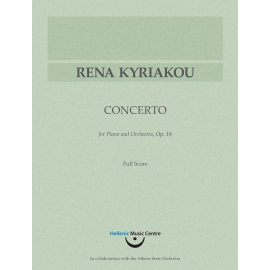

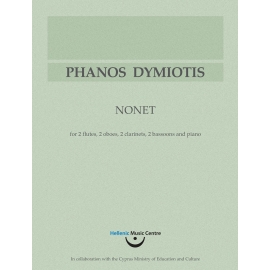


![Logothetis: Permutationen [Permutations]](https://hellenicmusiccentre.com/img/p/4/3/43-tm_home_default.jpg)
